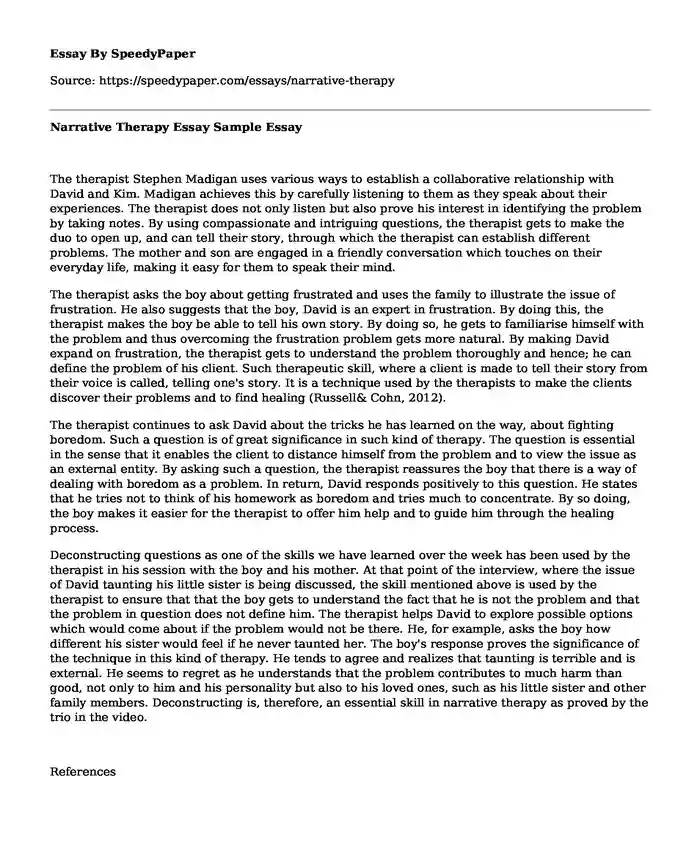
| Type of paper: | Critical thinking |
| Categories: | Counseling |
| Pages: | 3 |
| Wordcount: | 572 words |
The therapist Stephen Madigan uses various ways to establish a collaborative relationship with David and Kim. Madigan achieves this by carefully listening to them as they speak about their experiences. The therapist does not only listen but also prove his interest in identifying the problem by taking notes. By using compassionate and intriguing questions, the therapist gets to make the duo to open up, and can tell their story, through which the therapist can establish different problems. The mother and son are engaged in a friendly conversation which touches on their everyday life, making it easy for them to speak their mind.
The therapist asks the boy about getting frustrated and uses the family to illustrate the issue of frustration. He also suggests that the boy, David is an expert in frustration. By doing this, the therapist makes the boy be able to tell his own story. By doing so, he gets to familiarise himself with the problem and thus overcoming the frustration problem gets more natural. By making David expand on frustration, the therapist gets to understand the problem thoroughly and hence; he can define the problem of his client. Such therapeutic skill, where a client is made to tell their story from their voice is called, telling one's story. It is a technique used by the therapists to make the clients discover their problems and to find healing (Russell& Cohn, 2012).
The therapist continues to ask David about the tricks he has learned on the way, about fighting boredom. Such a question is of great significance in such kind of therapy. The question is essential in the sense that it enables the client to distance himself from the problem and to view the issue as an external entity. By asking such a question, the therapist reassures the boy that there is a way of dealing with boredom as a problem. In return, David responds positively to this question. He states that he tries not to think of his homework as boredom and tries much to concentrate. By so doing, the boy makes it easier for the therapist to offer him help and to guide him through the healing process.
Deconstructing questions as one of the skills we have learned over the week has been used by the therapist in his session with the boy and his mother. At that point of the interview, where the issue of David taunting his little sister is being discussed, the skill mentioned above is used by the therapist to ensure that that the boy gets to understand the fact that he is not the problem and that the problem in question does not define him. The therapist helps David to explore possible options which would come about if the problem would not be there. He, for example, asks the boy how different his sister would feel if he never taunted her. The boy's response proves the significance of the technique in this kind of therapy. He tends to agree and realizes that taunting is terrible and is external. He seems to regret as he understands that the problem contributes to much harm than good, not only to him and his personality but also to his loved ones, such as his little sister and other family members. Deconstructing is, therefore, an essential skill in narrative therapy as proved by the trio in the video.
References
Russell, J., & Cohn, R. (2012). Narrative therapy. Lennex Corporation.
Cite this page
Narrative Therapy Essay Sample. (2022, Aug 22). Retrieved from https://speedypaper.net/essays/narrative-therapy
Request Removal
If you are the original author of this essay and no longer wish to have it published on the SpeedyPaper website, please click below to request its removal:
- A Raisin in the Sun and Happiness Essay Samples
- Free Essay Sample: Belief and Compromise
- African Americans Following Reconstruction, Essay Example for You
- Working in Paradise - Free Essay about Google Campus
- Ethical Pressures Essay Sample for Everyone
- Paper Example - Windsor Spitfires
- Essay Sample on Ethical Issues in Advertising
Popular categories




